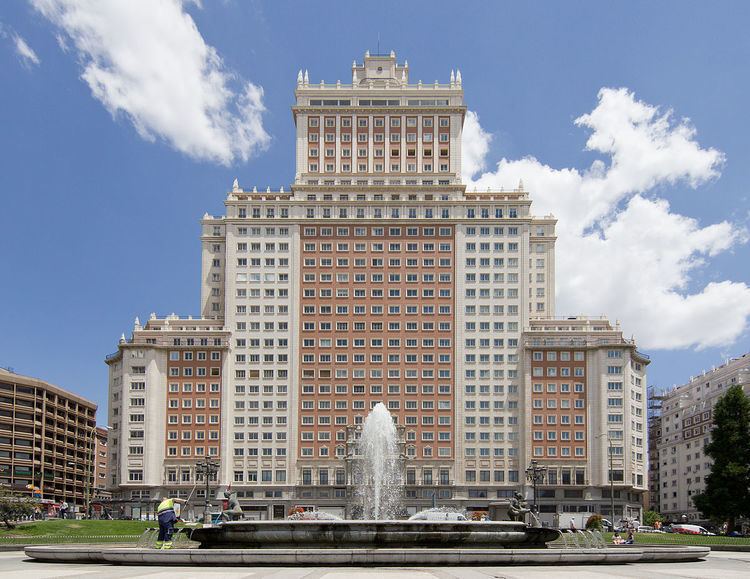Status Complete Completed 1953 Height 117 m | Construction started 1948 Roof 117 m (384 ft) Floors 25 | |
 | ||
Type Hotel, office (currently) Architects Joaquin Otamendi, Julian Otamendi Architectural styles Baroque Revival architecture, Neoclassical architecture Similar Plaza de España, Torre de Madrid, Torrespaña, Monumento A CERVANTES, Puerta de Alcalá | ||
En el interior del edificio espa a
The Edificio España (Spanish: Spain Building) is the 8th tallest building in Madrid, Spain, and one of the city's most iconic buildings. It is an example of 20th-century Spanish architecture built in the neo-baroque style. In 2014 it was purchased by Chinese real estate company Dalian Wanda.
Contents
- En el interior del edificio espa a
- qu va a pasar con el edificio espa a
- Early history
- In popular culture
- References
qu va a pasar con el edificio espa a
Early history
It was designed by architect Julián Otamendi and his brother in the Neo-baroque style and constructed from 1948 to 1953. It was a "symbol of prosperity" during the decades of Francisco Franco's Spain.
It was the tallest building in Spain, with 25 floors and a height of 117 m (384 ft), until overtaken by the Torre de Madrid (also built by Otamendi) in 1957. The building formerly housed the 360-room Hotel Plaza, later a Crowne Plaza Hotel, a shopping centre, apartments, offices, and a rooftop pool. Its profile, on Plaza de España at the end of the Gran Vía, complements the neighboring skyscraper Torre de Madrid, making the pair important architectural landmarks in the city.
Metrovacesa, which owned the structure since its completion, marketed it in April 2005 along with the neighboring Torre de Madrid to help finance its acquisition of French property company, Gecina.
In June 2005, Santander Real's investment fund acquired 50% of the building for €138.6 million and committed to purchase the remaining 50%, belonging to the hotel, shortly thereafter. The deal closed in early December 2007. Santander renovated the building, preserving intact the facade and the lobby as part of a project to build a hotel and apartments, but the project stalled in 2010.
The building was acquired in 2014 by Wang Jianlin's Chinese real estate company Dalian Wanda for "about a third less than the €389 million that Banco Santander paid in 2005, at the height of Spain’s construction boom". Dalian Wanda "plans to renovate the structure to include luxury apartments and a hotel as part of a broader overhaul of the neighborhood", and in January 2015 the Governing Board of the Community of Madrid approved the proposed refurbishment. Wang intends to "create a luxury hotel, more than 300 homes and a retail space, which he plans to expand to 15,000 sqm".
By the time it was purchased by Dalian Wanda, it had been empty for several years and "had become a symbol of the Spanish real estate market’s collapse in 2008" that marked the beginning of the Great Recession in Spain.
In January 2017 it was announced that the building will be remodeled into a 650-room Riu Plaza hotel.
In popular culture
The building is depicted in 1984 movie The Hit. A part of it is shot in an apartment in the nearby Torre de Madrid, from which the Edifico España is well visible.
In 2007 documentary filmmaker Víctor Moreno began "filming over 200 workers, mostly immigrants from all over the world, hired to demolish the interior" of the building with the approval of the building's then owner, Banco Santander. However, the bank reversed its position without explanation and blocked its release in Spain for 15 months. Despite the ban, the documentary was shown at the San Sebastián International Film Festival, Buenos Aires International Festival of Independent Cinema, and Doclisboa. It was eventually released in the movies in Spain in 2014.
